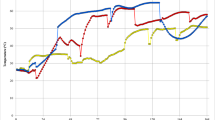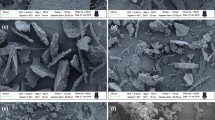Abstract
Aconiti Lateralis Radix Praeparata (ALRP) is commonly used traditional Chinese medicine in clinic, and it is usually in compatibility with ginger including Zingiberis Rhizoma (ZR), Zingiberis Rhizoma Recens (ZRR), and Zingiberis Rhizoma Praeparatum (ZRP) for treatment of diseases. In this paper, microcalorimetry and Cold/Hot plate differentiating technology (CHPD) were employed to explore the hot property differences of ALRP, together with its compatibility with different ginger processed products. By means of principal component analysis (PCA), the heat power of the second peak (P 2) and the total heat output (Q) which were the main parameters affecting the E. coli metabolism from the power-time curves were obtained. The results showed that the hot property of ALRP in compatibility with different processed ginger was in order of ZR + ALRP > ZRR + ALRP > ZRP + ALRP > ALRP. Meanwhile, the oxygen consumption and remaining rate (RR) in mice on warm plate suggested that the hot property of ALRP was totally different. The relationships between the main parameters (P 2 and Q) values and the observation indexes from CHPD were investigated with canonical correlation analysis. The correlation coefficient showed that parameter Q had a marked correlation with the observation indexes (R > 0.85). Altogether, based on bio-thermodynamics, the hot property differences of ALRP and its compatibility with different ginger processed products followed the order of ZR + ALRP > ZRR + ALRP > ZRP + ALRP > ALRP. This could provide guidance for clinical use of ALRP combining with different ginger processed products.






Similar content being viewed by others
Abbreviations
- ALRP:
-
Aconiti Lateralis Radix Praeparata
- TCM:
-
Traditional Chinese medicine
- ZR:
-
Zingiberis Rhizoma
- ZRR:
-
Zingiberis Rhizoma Recens
- ZRP:
-
Zingiberis Rhizoma Praeparatum
- CHPD:
-
Cold/Hot plate differentiating technology
- PCA:
-
Principal component analysis
- P 2 :
-
The heat power of the second peak
- Q :
-
The total heat output
- RR:
-
Remaining rate on warm plate
- CCA:
-
Canonical correlation analysis
References
Xiao PG, Wang FP, Gao F, Yan LP, Chen DL, Liu Y. A pharmacophylogenetic study of Aconitum L. (Ranunculaceae) from China one hour payday loan small payday loans payday loan no fax fast cash loans small. Acta Phytotaxon Sin. 2006;44:1.
Sharma E, Gaur A. Aconitum balfourii Stapf: a rare medicinal herb from Himalayan Alpine. J Med Plant Res. 2012;6:318–25.
Wu C. Research progress of the genus Aconitum. J Xingjiang Med Univ. 2011;10:1153–7.
Zhou G, Gong QF, Xu G. Herbalogical study on Tianxiong. Chin Herb Med. 2003;26:441–3.
von Ah U, Wirz D, Daniels AU. Isothermal microcalorimetry—a new method for MIC determinations: results for 12 antibiotics and reference strains of E. coli and S. aureus. BMC Microbiol. 2009;9:106.
Baldoni D, Hermann H, Frei R, Trampuz A, Steinhuber A. Performance of microcalorimetry for early detection of methicillin resistance in clinical isolates of Staphylococcus aureus. J Clin Microbiol. 2009;47:774–6.
Bermudez J, Backman P, Schon A. Microcalorimetric evaluation of the effects of methotrexate and 6-thioguanine on sensitive T-lymphoma cells and on a methotrexate-resistant subline. Cell Biophys. 1992;20:111–23.
Wenzler T, Steinhuber A, Wittlin S, Scheurer C, Brun R, Trampuz A. Isothermal microcalorimetry, a new tool to monitor drug action against Trypanosoma brucei and Plasmodium falciparum. PLoS Negl Trop Dis. 2012;6:1668.
Manneck T, Braissant O, Haggenmüller Y, Keiser J. Isothermal microcalorimetry to study drugs against Schistosoma mansoni. J Clin Microbiol. 2011;49:1217–25.
Kaper JB, Nataro JP, Mobley HL. Pathogenic Escherichia coli. Nat Rev Microbiol. 2004;2:123–40.
Kong WJ, Zhao YJ, Shan LM, Xiao XH, Guo WY. Investigation on the drug property differences of Zuojinwan and its similar prescriptions by microcalorimetry. J Chin Tradit Pat Med. 2008;71:787–92.
Zhao YL, Wang JB, Zhang P, Shan LM, Li RS, Xiao XH. Microcalorimetric study of the opposing effects of ginsenosides Rg1 and Rb1 on the growth of mice splenic lymphocytes. J Therm Anal Calorim. 2011;104:357–63.
Zhao HP, Zhao YL, WANG JB, Li HB, Ren YS, Zhou CP, Yan D, Xiao XH. Expression of the difference between cold (Han) and hot (Re) nature of Chinese medicines (strobal and rhubarb) based on the cold/hot plate differentiating assay. Sci China Ser C. 2009;52:1192–7.
Zhao YL, Wang JB, Xiao XH, Zhao HP, Zhou CP, Zhang XR, Ren YS, Jia L. Study on the cold and hot properties of medicinal herbs by thermotropism in mice behavior. J Ethnopharmacol. 2010;133:980–5.
Sun ZY, Zhao YL, Wang JB, Zhang L, Wei SS, Jiang FJ, Jia L, Cheng DH, Xiao XH. Research on Fuzi based on animal thermotropism behavior to discover if it has fewer “hot” characteristics without Ganjiang. J Tradit Chin Med. 2012;32:61–4.
Xie CL, Tang HK, Song ZH, Qu SS. Microcalorimetric study of bacterial growth. Thermochim Acta. 1988;132:33–41.
Paulo A, Luís M, Vasco G. Open control: a free open source software for video tracking and automated control of behavioral mazes. J Neurosci Methods. 2007;166:66–72.
Jackson JE. A user’s guide to principal components. New York: Wiley; 2005.
Pierce KM, Hope JL, Johnson KJ, Wright BW, Synovec RE. Classification of gasoline data obtained by gas chromatography using a piecewise alignment algorithm combined with feature selection and principal component analysis. J Chromatogr A. 2005;1096:101–10.
Chu D, Liao LZ, Ng MK, Zhang X. Sparse canonical correlation analysis: new formulation and algorithm. IEEE Trans Pattern Anal Mach Intell. 2013;35:3050–65.
Gumus E, Kursun O, Sertbas A, Ustek D. Application of canonical correlation analysis for identifying viral integration preferences. Bioinformatics. 2012;28:651–5.
Li X, Zhang T, Min XM, Liu P. Toxicity of aromatic compounds to Tetrahymena estimated by microcalorimetry and QSAR. Aquat Toxicol. 2010;98:322–7.
Matthias B, Simon SPA, Georg F. Benzoyl-CoA reductase (dearomatizing), a key enzyme of anaerobic aromatic metabolism: a study of adenosinetriphosphatase activity, ATP stoichiometry of the reaction and EPR properties of the enzyme. Eur J Biochem. 1997;244:840–51.
Huang XQ, Tang J, Zhou Q, Lu HP, Wu YL, Wu WK. Polysaccharide from Fuzi (FPS) prevents hypercholesterolemia in rats. Lipids Health Dis. 2010;9:9.
Liu HJ, Jin RM, Qi SY, Mei CX, Tang LM. Effect of peppermint oil on GSH and ATPase in rat liver-tissues and primary cultured rat hepatocyte. Chin Tradit Pat Med. 2008;30:644–7.
Zhang WT, Tang HQ, Lu AN, Wang XY, Yang Y, Luo J, Yang MJ, Li GZ, Jiang YF, Cai DY. Fuzi Lizhong Pills regulating myosin ATPase activity of skeletal muscle in rats with spleen yang deficient syndrome. Chin J Tradit Chin Med Pharm. 2011;26:490–4.
Wang XM, Fu H, Liu GX. Effect of Herba Epimedii and Fructus Lycii on mitochondrial DNA deletion, activity of respiratory chain enzyme complexes and ATP synthesis in aged rats. J Peking Univ (Health Sci). 2002;34:68–71.
Cui X, Zuo PP, Zhang Q, Li XK, Hu YZ, Long JG, Packer L, Liu JK. Chronic systemic d-galactose exposure induces memory loss, neurodegeneration, and oxidative damage in mice: protective effects of R-alpha-lipoic acid. J Neurosci Res. 2006;83:1584–90.
Acknowledgements
We are grateful for the support of the National Natural Sciences Foundation (No. 81173571), National Basic Research Program of China (No. 2007CB512607), and the Major Projects of the National Science and Technology (2012ZX10005010-002-002).
Author information
Authors and Affiliations
Corresponding author
Rights and permissions
About this article
Cite this article
Chen, Z., Zhao, Y., Liu, S. et al. Study on hot property differences of Aconiti Lateralis Radix Praeparata and its compatibility with different ginger processed products based on bio-thermodynamics. J Therm Anal Calorim 120, 1043–1051 (2015). https://doi.org/10.1007/s10973-014-4032-8
Received:
Accepted:
Published:
Issue Date:
DOI: https://doi.org/10.1007/s10973-014-4032-8




